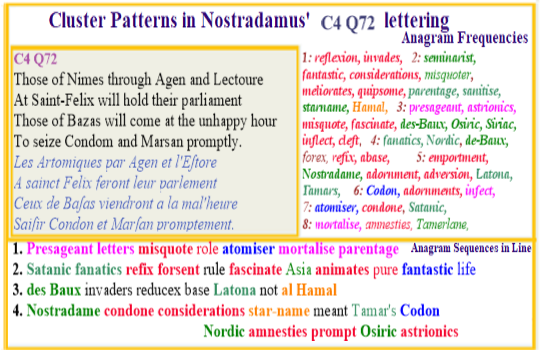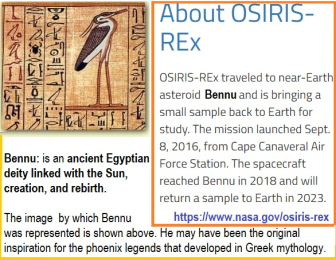 Analyses of all verses
Analyses of all verses
|
 Web Site
Web Site |
 All
Sefirots All
Sefirots |
Nostradamus C4 Q72: Critique of those who restrain his study of the stars
Copyright: Allan Webber, December 2015, Feb 2023
 C4
Q72
is part of the lead pair in my codon series and the aspect common to this
pair is their linking codon research events to astronomic events at the
end of the 21st century.
C4
Q72
is part of the lead pair in my codon series and the aspect common to this
pair is their linking codon research events to astronomic events at the
end of the 21st century.
The defining structure of this verse is set by anagrams about Nostradamus' usage of astronomy to give the timing of Genetic events. This pattern emerges through anagrams found in the fourth line. In that location the reader can see anagrammatic words reflecting his interest as well as his focus points: Nostradame, considerations, Nordic, star-name, prompt and Tamar's codon (don et Marſa / Saiſir Condon et / ir Con d / n et Marſa / prompt // t Marſa / Condo )
 This verse embraces many interrelated issues making it a pivot point
for many of Nostradamus' story lines.
This verse embraces many interrelated issues making it a pivot point
for many of Nostradamus' story lines.
The finding of the name Tamar in the same line as codon and Nostradame' considerations unites them in the same cohesive fashion seen in other verses.
Tamar is the name of the female whose Christ based lineage is at the heart of legends in southern France and elsewhere. That tale in Nostradamus based story lines reaches into this century when genetic technology can possibly recreate beings from ancient DNA.
There are many anagrams in the other lines that reinforce this picture. These include fanatics, mortalise, parentage, refix, life and presageant with the last of these terms representing a trait in several verses of this series namely the concept of seeing across the barriers of time. This attribute is linked by these Nostradamian entries to genetic capacities emerging in our era and beyond.
The anagrams also show that this interest takes him into a study of the stars and their impact on the belief systems of Southern France including that of the Lord of Les Baux and the regions around Agen. Les Baux and Agen are both towns with which Nostradamus was very familiar since he spent important developmental years in or near each.
 The story line
based on the anagrams in this verse considers the manner in which different people in different
eras have adjusted to their understanding of the stars.
The story line
based on the anagrams in this verse considers the manner in which different people in different
eras have adjusted to their understanding of the stars.
This is reflected by terms relating to the stars in cultures such as ancient Egypt and the Nordic Vikings.
It is interesting that the present and future constantly come together through the legends of ancient cultures. As you can see in the accompanying picture even a modern institution (NASA) acts out a role by naming its missions consistent with those prominent in ancient history.
# Parques: French name for the Roman Parcae who were female personnifications of destiny. They were often called the Fates in English. In latin their names were Nona, Decima and Morta.